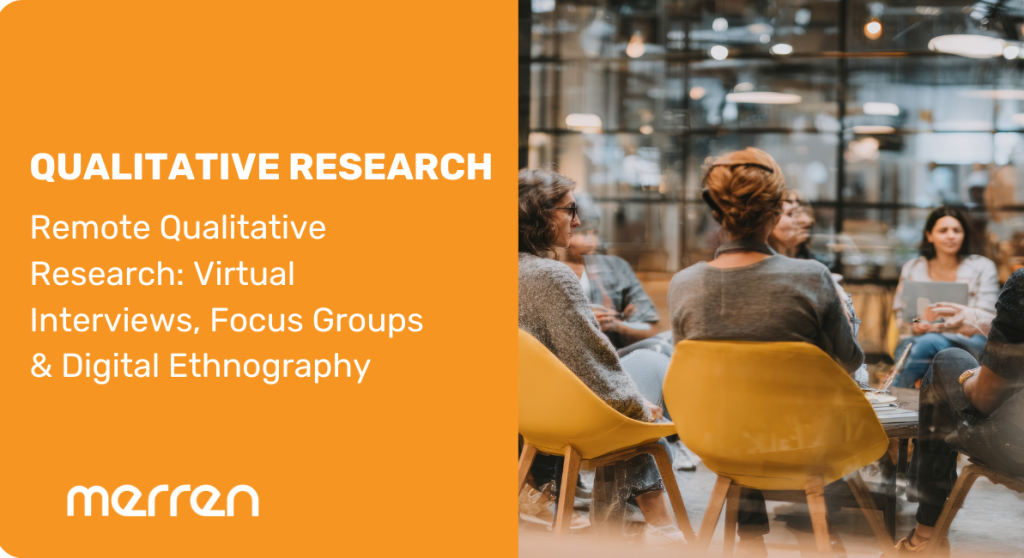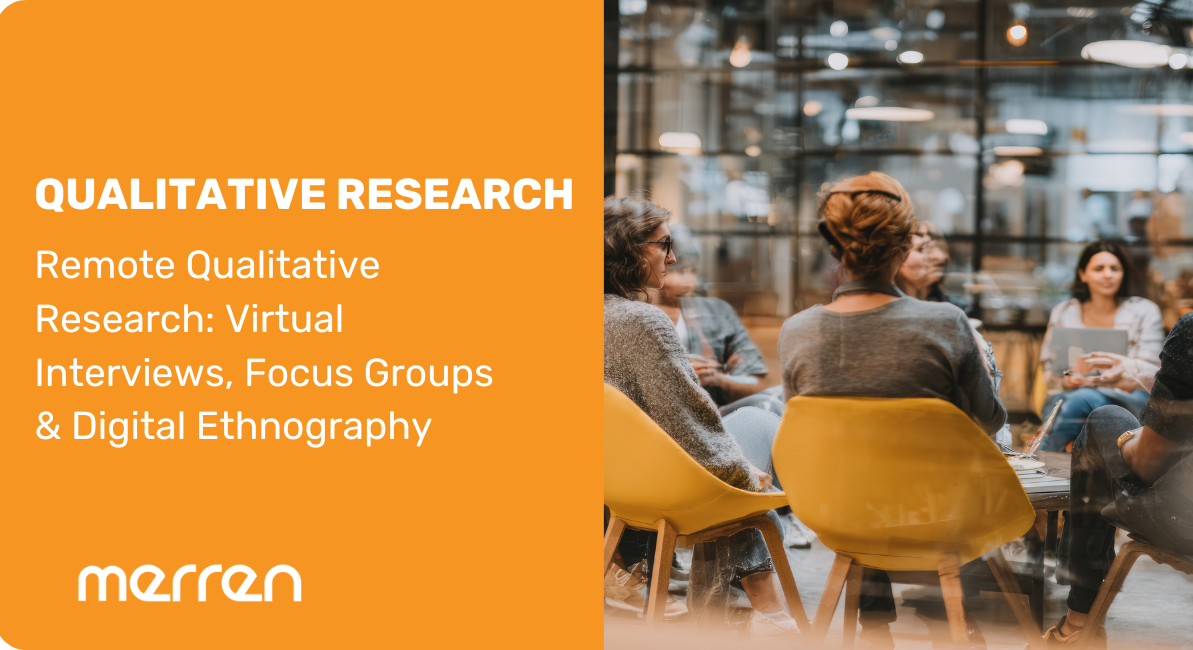Qualitative research has changed dramatically over the last decade. What once required in-person interviews, physical focus groups, and field ethnography can now be done virtually with AI-led tools from Merren. Remote qualitative research has opened doors for global collaboration, faster turnaround, and access to participants who were once hard to reach.
In this blog, we’ll explore what remote qualitative research is, its main methods, and best practices for conducting virtual interviews, focus groups, and digital ethnography.
What is Remote Qualitative Research?
Remote qualitative research collects non-numerical, experience-based data through digital platforms instead of face-to-face sessions. Researchers connect with participants via video calls, online chat, mobile diaries, or messaging platforms to explore perceptions, motivations, and experiences in natural settings.
Unlike traditional research methods, remote qualitative research removes geographic boundaries and logistical limitations. It’s increasingly being used by customer experience (CX) teams, marketers, and UX researchers to understand their audiences in real-time environments.
Why remote qualitative research matters
- Broader reach: Engage participants from multiple locations and time zones without travel costs.
- Real-world authenticity: Participants share experiences from their own environments, increasing naturalness and context.
- Speed and convenience: Faster scheduling, easier data collection, and quicker analysis.
- Cost-effective: No travel, facility rental, or equipment expenses.
- Sustainable: Lower carbon footprint and resource use.
Types of Remote Qualitative Research
Depending on the research objective, there are three main ways to conduct remote qualitative studies: virtual interviews, online focus groups, and digital ethnography. Each offers unique strengths for different market research goals.
1. Virtual in-depth interviews (IDIs)
Virtual in-depth interviews are one-on-one conversations conducted via platforms like Merren by Maya AI, Zoom, Google Meet, or specialized research tools. They mirror traditional interviews but happen online.
Advantages:
- Flexibility in scheduling across time zones.
- Easier participation where respondents can join from anywhere.
- Ability to capture emotional metrics.
Challenges:
- Screen fatigue and shorter attention spans.
- Possible distractions in participants’ surroundings.
- Technical issues such as poor internet or camera problems.
Best Practices:
- Keep sessions short (30–45 minutes) to maintain engagement.
- Start with small talk to make participants comfortable.
- Record sessions (with consent) for accurate transcription and analysis.
- Use digital probes like “Tell me more about that” to deepen understanding.
2. Online focus groups
Online focus groups bring together 5–6 participants in a virtual room to discuss shared topics, concepts, or experiences. These can be live (synchronous) or asynchronous (threaded discussions over a few days).
Advantages:
- Diverse opinions in a short time.
- Easier coordination compared to physical focus group facilities.
- Visual prompts (e.g., images, prototypes) can be shared on-screen for concept testing.
Challenges:
- Some voices can dominate the conversation.
- Building group chemistry is harder virtually.
Best Practices:
- Conduct a tech check before starting the session.
- Keep groups small (5–6 people).
- Use polls or reaction emojis to keep discussions lively.
- Establish clear guidelines for participation and confidentiality.
- Use breakout rooms for subgroup discussions if needed.
3. Digital and mobile ethnography
Digital ethnography, sometimes called mobile ethnography, involves observing how participants use products, services, or environments in their natural surroundings. The goal i to see how products blend into the schedules of users. Participants share videos, photos, and diary entries through mobile apps or messaging platforms.
Advantages:
- Captures genuine, real-life behavior instead of recall-based responses.
- Reveals emotional and contextual cues often missed in interviews.
- Excellent for product usage studies and CX journey exploration.
Challenges:
- Participants may forget to record or post regularly.
- Requires clear instructions to maintain consistency.
Best Practices:
- Provide specific prompts (e.g., “Show how you prepare your morning coffee using our product”).
- Keep diary tasks short and engaging.
- Follow up with clarifying questions through chat or short video calls.
- Reward participation with small incentives to ensure engagement.
Conducting Remote Qualitative Research: Best Practices
While remote qualitative research offers convenience and flexibility, its success depends on how well it’s planned and executed. The following best practices help ensure quality, reliability, and depth in virtual data collection.
1. Plan with empathy and precision
Remote participation is often squeezed between work and personal life. Regard the participants’ time to get the best responses out of the campaign. Empathy based planning and transparency gets higher engagement.
What can be done:
- Send clear instructions about the session format, tools, and duration.
- Offer flexible scheduling options.
- Explain privacy and data security upfront.
- Confirm consent for recording and note-taking.
- Pilot test the discussion guide to identify potential digital barriers.
2. Choose the right digital environment
Technology can make or break your remote study. Choose platforms that balance usability with research-grade features.
Here is how Maya AI can help:
- Maya AI conducts conversational interviews with human-like empathy
- Maya AI can assess emotional metrics and create intelligent questions based on previous responses
- Maya AI is compatible across multiple devices and can work simultaneously across geographies.
3. Build virtual rapport
Building rapport through a screen takes deliberate effort. Participants open up more when they feel comfortable and understood. Maya AI is designed to build rapport with participants to help them respond openly in an online interview.
Ways to build trust remotely:
- Start with casual, open-ended questions before diving into research topics.
- Maintain eye contact through the camera.
- Use warm, empathetic language and nods to acknowledge responses.
- Mirror participant tone. If they are reflective, be patient; if enthusiastic, match energy.
4. Optimize data quality
High-quality qualitative data depends on both depth and authenticity.
How to ensure this:
- Record all sessions (with consent) and transcribe them for coding.
- Use visual aids or screen sharing for product or concept feedback.
- Probe for emotional responses: “How did that make you feel?” or “Can you walk me through your thought process?”
- Encourage elaboration instead of short, surface-level answers.
Maya AI helps researchers transcribe, analyze, and summarize qualitative data quickly, reducing manual workload and improving insight quality.
5. Ensure inclusivity and accessibility
Remote qualitative research can reach wider audiences, but not everyone has equal access to technology.
Inclusivity tips:
- Maya AI offers multilingual moderators or translation support for global audiences.
- Avoid heavy file-sharing if participants have low bandwidth.
- Provide the option for phone interviews or audio-only participation.
- Check time zone compatibility before scheduling sessions.
Analyzing Remote Qualitative Data
Once data is collected, the next step is transforming it into insights that inform decision-making. Remote qualitative data is usually rich, but scattered across recordings, transcripts, and chat logs.
Step-by-step guide to analysis:
- Transcribe sessions: Use automated tools to save time.
- Code data thematically: Identify recurring ideas, emotions, and patterns.
- Cluster themes: Group codes into overarching themes or narratives.
- Interpret context: Go beyond words — analyze tone, pauses, and expressions.
- Summarize visually: Create word clouds, thematic maps, or short quotes to illustrate findings.
Pro tip: Combining AI-assisted transcription and coding (like Maya AI) with human interpretation gives the best results in speed with accuracy.
The Future of Remote Qualitative Research
Remote qualitative research is evolving fast, driven by technological innovation and the growing need for continuous, agile insight.
Key Trends to Watch:
- AI-powered moderation: Tools like Maya AI can conduct adaptive interviews, ask intelligent follow-ups, and summarize key insights automatically.
- Asynchronous methods: Participants contribute at their own pace via text, voice, or video for minimal fatigue.
- Integration with CX dashboards: Qualitative insights can now flow directly into analytics systems for real-time action.
- Hybrid approaches: Blending live digital sessions with self-recorded video diaries for richer, multi-dimensional data.
Conclusion
Remote qualitative research has proven that empathy, adaptability, and technology can coexist beautifully. Whether it’s a virtual interview, an online focus group, or a mobile ethnography project, remote research enables brands to connect with their audiences authentically from anywhere in the world.
Maya AI delivers all the above features and promises to uplift the work on qualitative research. Maya AI is an AI-driven customer research tool that can work with any industry for any type of audience.

